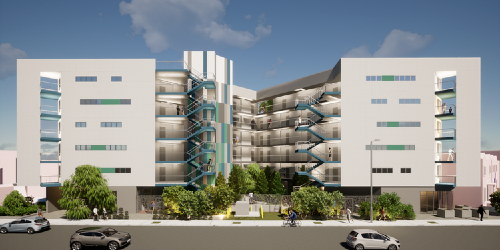Countywide, more than 66,000 people experienced homelessness last year, according to the Los Angeles Homeless Services Authority. And other people are struggling to pay rent, devoting large portions of their income to housing costs, studies show.
Several developers, however, are looking to build more affordable housing and supportive and transitional units for the homeless.
Brentwood-based Thomas Safran & Associates, Long Beach-based Linc Housing Corp. and downtown-based Abode Communities are among the local companies trying to make a dent in the number of affordable units needed now.
“There’s a really dire need for affordable housing in L.A.,” Sonnet Hui, general manager and vice president at Project Management Advisors Inc., said. “There are multiple factors that led to that situation. It is extremely expensive to build in L.A., the construction costs are high, labor costs are high and then, CEQA (the California Environmental Quality Act), and the permitting process is very complicated and takes many years. All of those factors add to the housing affordability issue in Los Angeles.”
She added that she is seeing more affordable housing projects being proposed and developed now despite the issues associated with building them and expects to continue to see more.
These projects, she said, take years to complete but, “the need is now.”
And one of the most difficult parts of affordable and supportive housing developments can be funding.
Funds, developers say, can be hard to get. Often one development can have as many as a dozen funding sources, including tax credits, traditional loans and Proposition HHH funding.
Keith McCloskey, an associate principal at architecture firm KTGY Architecture and Planning, has been doing a lot of work on affordable housing projects. He said funding made available by Proposition HHH “helped spark some momentum to help take a stab at putting a dent in the homeless populations though costs have been known to be a challenge.”
A lot of project funding has to be secured ahead of time instead of as the project is progressing, which can also be a bit tricky, experts agree.
Many of the developers creating affordable housing now are nonprofits, but Hui said some for-profit developers are also looking into affordable housing, and some are including affordable units in their market-rate developments as well.
“We’re seeing an incredible amount of support in terms of bond money and legislation,” Mark Oberholzer, an associate principal at KTGY, added. “There’s significant legislation that’s happened in the last couple of years that has helped developers make affordable housing projects pencil better. That has helped shift the focus from a small sliver … to opening up the conversation a little bit broader to mixed-income affordable developments and as a byproduct an interest in for-profit developers in addressing workforce housing.”
One major trend in affordable housing now, and one people in the industry see increasing in years to come, is the use of modular construction.
These units are created in factories at the same time the sites are prepped. Experts say this method can save a lot of time and money on holding costs since the projects are completed faster. Units are checked by the state, while local authorities check the site itself.
Oberholzer estimated that there are now thousands of modular units in various stages of production in L.A. because of the “dissatisfaction with the pace of housing production.”
“It just takes too long and costs too much per unit (to build), and that really has people interested industrywide in innovation, and that’s really led to modular,” he said. “You see it more in the affordable housing world because those projects tend to have higher costs driven by the competitive nature of some of the funding and the higher wages that are required for those projects.”
And Oberholzer said he thinks costs associated with modular units will come down, which may help with even more interest.
Keith said he is also seeing more people look into modular units than in the past.
Looking forward, consultants and architects expect to see more affordable housing built, both as modular units and using more traditional construction.
“I think we’re going to see more interest and pressure to use underutilized public land,” Oberholzer said. “Having the site is half the battle to getting a project developed.”
Hui added that she expects the city to speed up the process of getting affordable housing projects approved and making more funding available, leading to more being built.
Projects expected to open next year include Adams Terrace in Jefferson Park, which will have 41 affordable units, 43 supportive units and two manager units; HiFi Collective in Westlake, which will have 63 supportive housing units and one manager’s unit; and The Nook in South Whittier, a former library that will have 27 units for 18- to 24-year-olds in need of stable housing.

